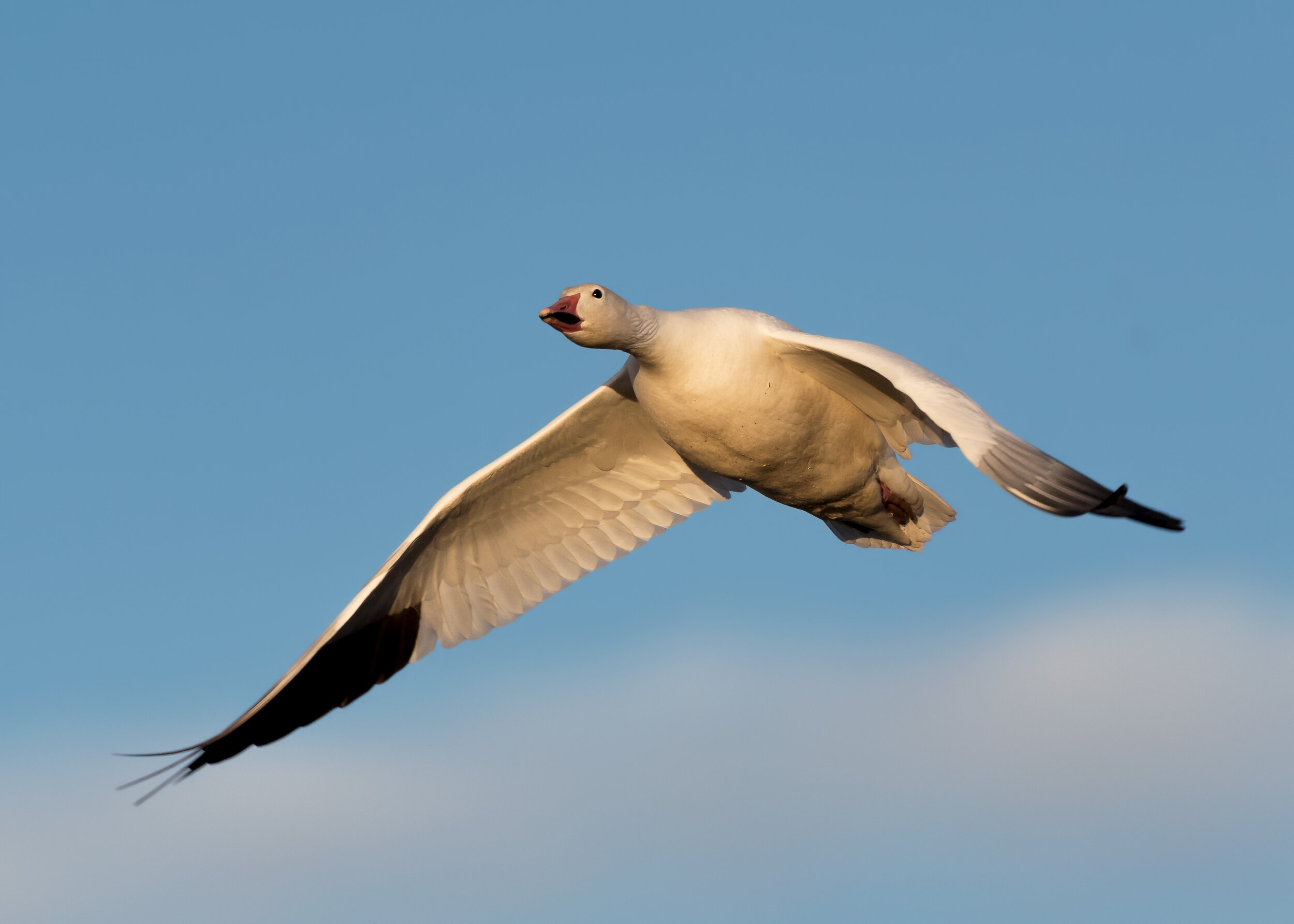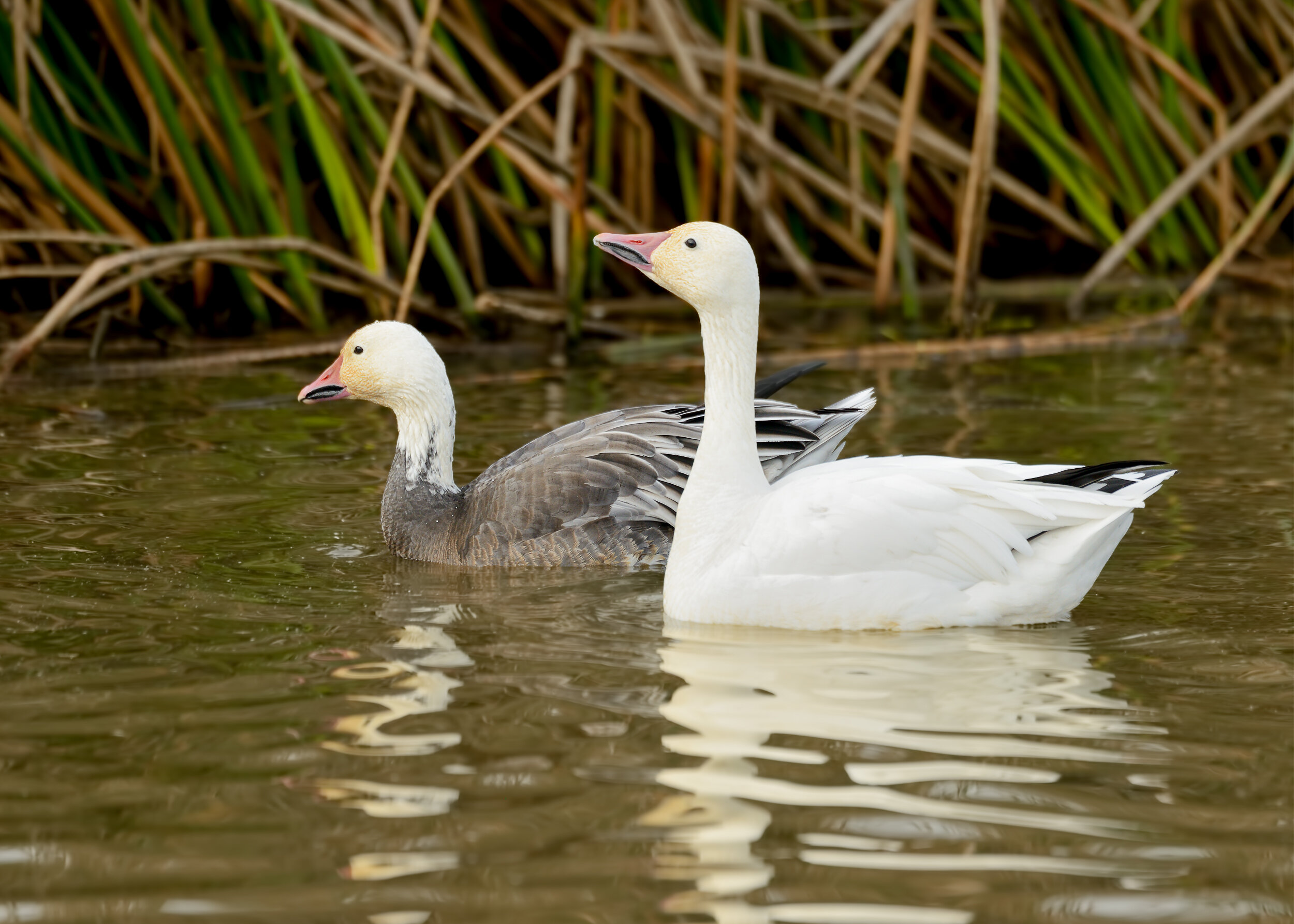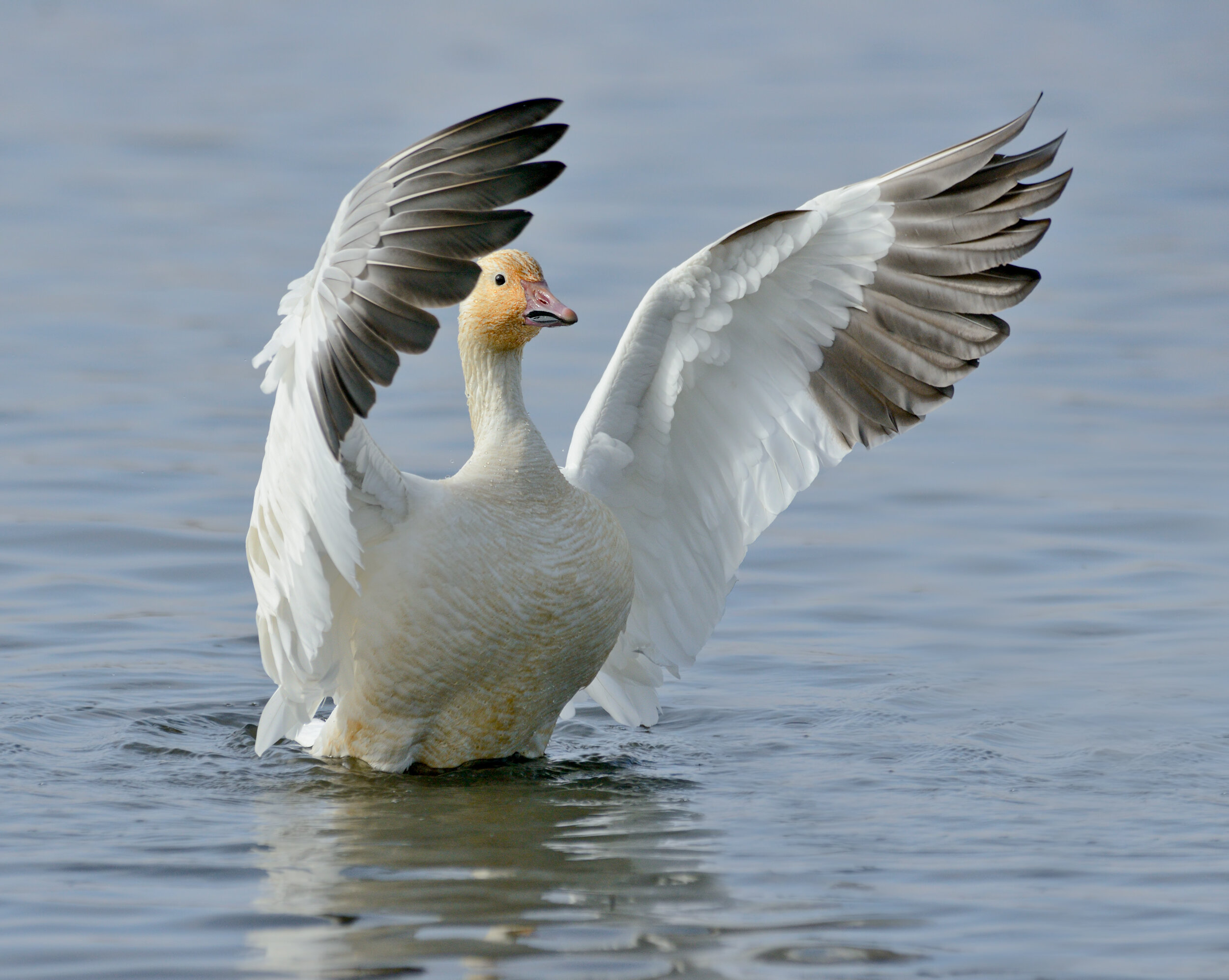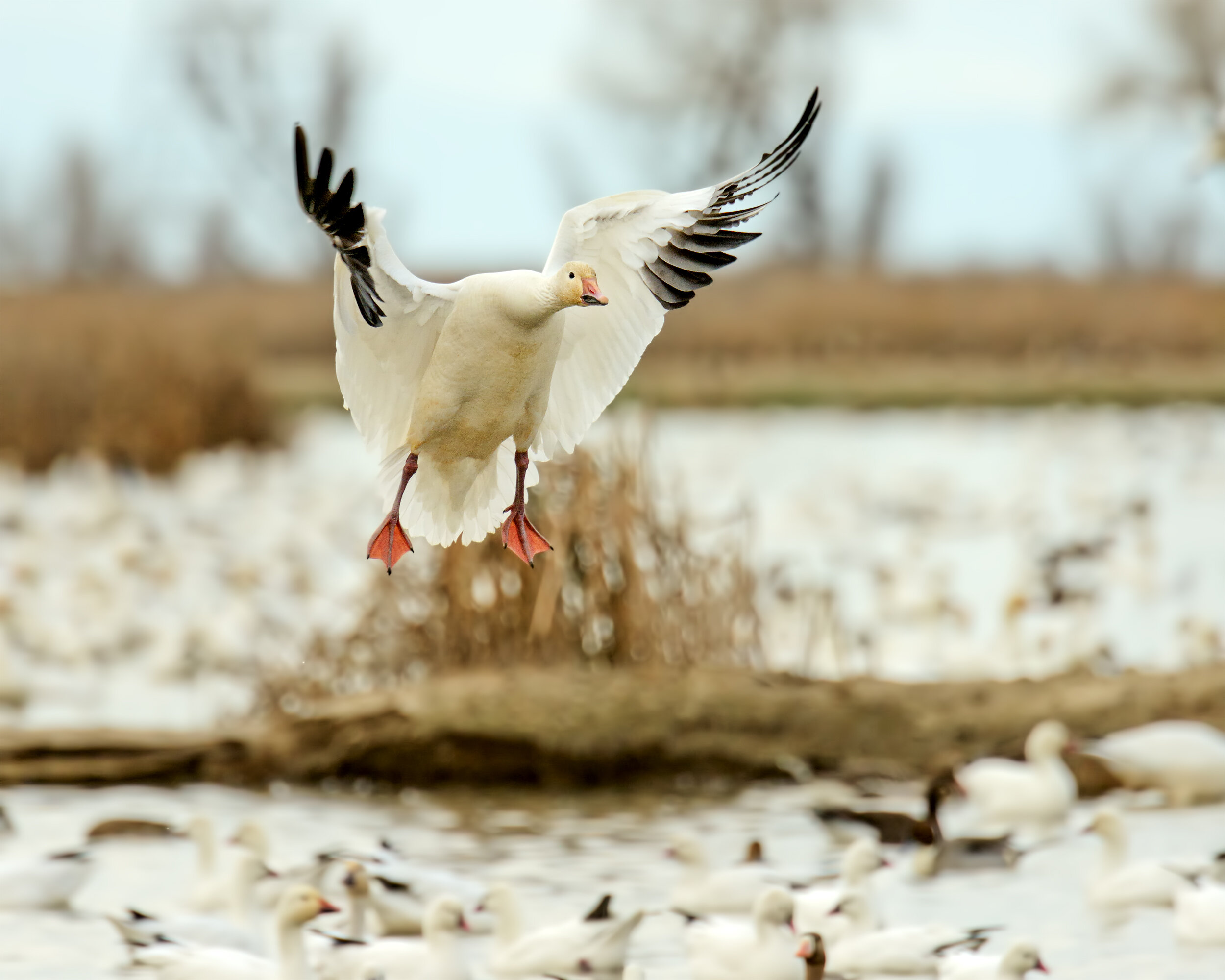Adult Snow Goose, Image by Daniel Lee Brown
This month let’s learn about another fascinating bird called the Snow Goose (Anser caerulescens). Snow Geese are one of the most abundant waterfowl in North America. They begin nesting in late spring or summer in the arctic tundra (the extreme northern regions of Alaska, Canada, Greenland, and Russia) where it can be icy cold in winter and trees never grow due to environmental conditions. In the fall, Snow Geese migrate south to the United States using one of the four major North American flyways (or bird migration routes). They travel as far south as Mexico. Snow Geese, like many other species of birds, migrate to where there is more food in the winter. Although the Snow Goose population is extremely large in the United States in the winter, Snow Geese only gather in specific habitats in each region. Some of the best places to see Snow Geese in our area are the National Wildlife Refuges: Gray Lodge, Colusa, and Sacramento.
Snow Geese usually walk on the ground (or wade in shallow water) for several hours a day to search for food. They sleep sitting on land, standing on one leg, or even while swimming.
Around March, Snow Geese head north again for spring migration. They usually fly in groups of at least two dozen birds; but often gather into flocks of several hundred thousand birds! Snow Geese flocks fly in a U pattern or a “messy” line formation. Traveling in flocks offers birds greater protection from predators and increases their success rate for finding food sources. During migration, Snow Geese travel for long distances and will fly over the same routes and stop in the same places they have used historically.
Snow Geese are divided into two subspecies: greater and lesser. In fall, the lesser subspecies (A. c. caerulescens) migrate to several regions in the United States. In contrast, Greater Snow Geese (A. c. atlantica) only migrate to areas close to the eastern U.S. coastline. In the Sacramento Valley, the Lesser Snow Goose is the subspecies that’s usually seen.
What do Snow Geese look like?
Adult Snow Goose, Image by Daniel Lee Brown
Male and female Snow Geese look alike; but females are often smaller than males. Lesser Snow Geese have variations in plumage (or feather) color. The color pattern seen most often in the Sacramento Valley is the light- or white-morph. Light-morph Snow Geese are mostly white, have thick long necks, pink legs, pink feet, and pinkish-orange bills. The Snow Goose’s bill has a horizontal black streak running along the bottom half which is referred to as the grin patch. The ‘grin patch’ is a very helpful tool used to identify this species. Snow Geese also have black wingtips (a group of wing feathers called primaries). Their black primaries tend to be more noticeable in flight. Frequently Snow Geese will have orange-stained faces and heads caused by iron in the soil where they forage (or search) for food. Juvenile white-morph Snow Geese are partially white. They have black primaries, dark bills, and grayish-brown smudges on their heads, necks, and wings.
Adult Snow Geese: blue-morph on left, and white-morph on right, Image by Daniel Lee Brown
The second color form of the Lesser Snow Goose is the dark- or blue-morph. These darker birds are seen less often in the Sacramento Valley. The blue-morph Lesser Snow Geese have dark-brown or dark slate-gray bodies, white heads, and a variable amount of gray and white on the underside. Birds with this darker coloration also have the characteristic ‘grin patch’. Juvenile “blue morphs” have an overall dark-brown plumage and have dark bills and legs.
The Greater Snow Geese subspecies, found along the eastern coast of the United States, rarely has any color variations like lesser Snow Geese do.
Where do Snow Geese live?
Adult Snow Geese: a blue-morph along with several white-morph, Image by Mary Forrestal
Usually around late May or June, Snow Geese build their nests in the arctic tundra along shallow rivers, on small islands with surrounding shallow lakes, in low grasses, or among Arctic willows. They often nest in colonies (groups of animals or plants living close together). Pairs generally will remain together for life and begin to nest when they reach 3 years old. Female Snow Geese lay eggs once per year and choose the nest sites. Female birds also build nests in a shallow depressions on the ground among grasses, rocks, shrubs. They use grasses, leaves, twigs, or seaweed to make the base of the nest. Then the nest is lined with the females’ own down feathers. Some sources say male feathers are also used. Female Snow Geese tend to choose sites which are slightly elevated so there is better visibility to spot potential predators. Males stand guard while the females spend most of their time incubating the eggs (keeping eggs warm by sitting on them). Females incubate their eggs for 22 to 25 days and don't consume much food during this period. A few hours after hatching, the goslings (or baby geese) will quickly leave the nest. They immediately start feeding themselves while their parents watch over them. Family groups can walk for hours searching for food. The young will start to fly in about 40-50 days; but often remain near the family until they are about 2-3 years old.
When they migrate south in the fall, Snow Geese are found in wetlands or agricultural fields, such as plowed cornfields. They can also be found in or near lakes, bays, ponds, and coastal salt marshes.
What do Snow Geese eat?
Adult Snow Goose, Image by Daniel Lee Brown
Snow Geese are mainly vegetarians and eat grass, water plants, shrubs, seeds, stems, horsetails, and willows. Because their diet consists mainly of plant life and they are fairly large birds, Snow Geese must spend a long time each day foraging for food in order to eat enough to survive. They dig up roots, shoots, and tubers in muddy fields and marshes and will consume nearly any part of a plant. Snow Geese have serrated (having a saw-like or jagged edge) bills and tongues that help them cut and tear the strong marsh plants. In the winter, Snow Geese will eat the waste grains found in plowed agricultural fields. Goslings may eat flowers, fruits, plant shoots, and insect larvae.
What do Snow Geese sound like?
Snow Geese are extremely vocal and can be heard about a mile away. Their call has been described as hoarse, nasal, or honking. Researchers think that the continuous calling of geese flocks in flight helps to maintain the organized pattern or formation of the flock. You can listen to Snow Geese now.
These calls of the Snow Goose are from xeno-canto. More Snow Goose vocalizations can be found at xeno-canto.org/species/Anser-caerulescens.







